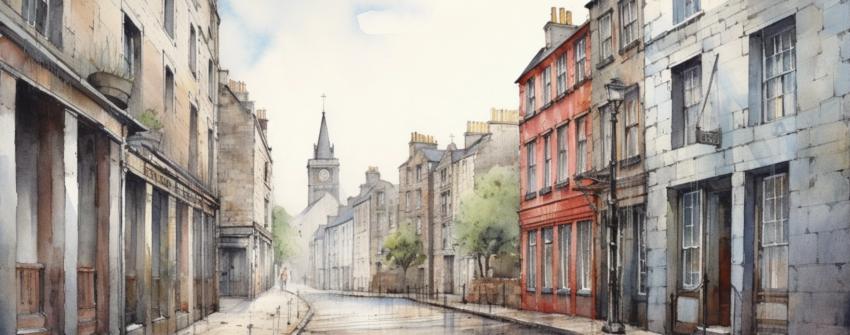Greenock: A Swagger through the Crazed Heart of Scottish Charm
 Greenock! A town as Scottish as a thistle-hugging, bagpipe-playing, kilt-donning Highlander, teetering on the edge of the River Clyde. Picture Glasgow, slightly tipsy, with a few shots of maritime madness, and you get Greenock. A town wrapped in a wild tartan pattern of industry, history, and an accent that even Google Translate would surrender to.
Greenock! A town as Scottish as a thistle-hugging, bagpipe-playing, kilt-donning Highlander, teetering on the edge of the River Clyde. Picture Glasgow, slightly tipsy, with a few shots of maritime madness, and you get Greenock. A town wrapped in a wild tartan pattern of industry, history, and an accent that even Google Translate would surrender to.I arrived in Greenock by train, my eyes stinging from the Scottish mist and my head buzzing from the chaos of Glasgow's infernal clamor. I was welcomed by a collection of stone-faced buildings as stern and unforgiving as a puritanical schoolmarm. It was a town with character, full of rusting promise and sugary dreams, overshadowed by brooding hills that sat on the horizon like surly gatekeepers.
The cobblestone streets echoed with the ghostly whispers of a bygone era. It was as if the spirits of shipbuilders, sugar barons, and sailors were engaged in a never-ending ceilidh. The town seemed to hum with an energy, a vibrancy that was as infectious as it was inspiring.
Stalking the streets of Greenock was like walking through a grand theatrical set designed by a cubist on a whiskey bender. The Victorian architecture seemed to veer between stately grandeur and kooky charm, reflecting the schizophrenic soul of the town. There was a peculiar beauty to it, a symmetry to the chaos that was as compelling as it was baffling.
Next on my mad dash was Greenock's beacon of Victorian affluence, the McLean Museum and Art Gallery. The exterior belied the treasure trove within - a cosmic mishmash of everything from mummies to Monets. As I wandered the labyrinthine corridors, I felt like Alice lost in a surreal wonderland of art, history, and taxidermy.
No trip to Greenock would be complete without paying homage to the town's sugary past. Greenock, it appears, has a sweet tooth that could make Willy Wonka balk. Its role as the European sugar capital has given birth to an almost fanatical love for the sweet stuff. One nibble of the infamous "Sugar Ship" dessert, and I was convinced the town's water supply was laced with glucose.
The highlight of my Greenockian adventure was the infamous Greenock Cut, an old aqueduct now masquerading as a walking trail. Offering a panoramic view of the Clyde and the surrounding landscape, it felt like being high on a cocktail of fresh air, breathtaking vistas, and a sense of serenity that bordered on the profound.
As I ventured deeper into the belly of the town, I found myself immersed in a world that was a fantastical blend of the ordinary and the extraordinary. It was as if reality had taken a vacation and left its eccentric cousin in charge. Yet, amidst the peculiarity, there was a sense of authenticity, a warmth that was as comforting as a dram of peaty Scotch on a frosty night.
As the day bleeds into twilight, Greenock takes on a softer hue. The industrial edges blur, the Clyde glistens, and the town seems to exhale, a sigh echoing with tales of sugar, ships, and undeniable Scottish spirit. And so ... as the sun sets over the Clyde, you find yourself in a pub, face-to-face with a pint of local ale. There, beneath the warm glow of the dimmed lights, amidst the spirited chatter, the peculiar charm of Greenock begins to seep into you. It's the realisation that the town, much like the ale you're sipping, is robust, a bit nutty, and utterly delightful.
As I prepared to bid adieu to Greenock, I couldn't help but feel a sense of bittersweet nostalgia. It was a town that danced to its own quirky tune, unapologetically Scottish and delightfully eccentric. And somewhere, amidst the sugar-crazed culinary adventures, the maritime tales, and the bewitching landscapes, Greenock had seared its tartan pattern onto my soul.
Article kindly provided by myfavouritehols.com
Latest Articles
- How to Plan Around Peak Congestion Days for Mountain Trips
- Mapping Your First Mountain Resort Loop Without Losing Your Sanity
- How Pro Kitchen Renovations Quietly Increase Booking Confidence in Self-Catering Stays
- Discover a City's Real Character From the Backseat
- How to Make Airport Layovers Surprisingly Productive
- From HVAC to ROI: the Hidden Economics of Sustainable Hotel Design
- How to Plan Your Day Tours to Minimize Crowds and Maximize Serendipity
- From Tourist to Observer: How to Photograph a City Like a Local
- Seasonal Shifts in Abandoned Turkish Valleys Reveal Clues About Heritage Site Decay
- Mastering Group Travel Planning for Events in Fort Lauderdale
- Beyond the Beach Bus: Hidden Palm Beach Spots Worth the Group Ride
- Chrono-Travel and Time Zone Acrobatics on a Coach
- Hidden Miami Charter Bus Routes to Secret Beaches, Local Food Gems, and Underrated Attractions
- More Than Just Ice - Unexpected Events at Amerant Bank Arena
- Madrid's Strangest Museums and Attractions You Never Knew Existed
- Disaster-Proof Rentals: A Flood-Resilient Guide for Holiday Homeowners
- Following the Footsteps of Filmmakers: Morocco's Iconic Movie Locations You Can Visit
- Hidden Gems Along Morocco's Coastline
- Tastes of Miami: Culinary Tours for the Global Foodie
- Milwaukee's Hidden Green Gems: Nature's Best Kept Secrets

